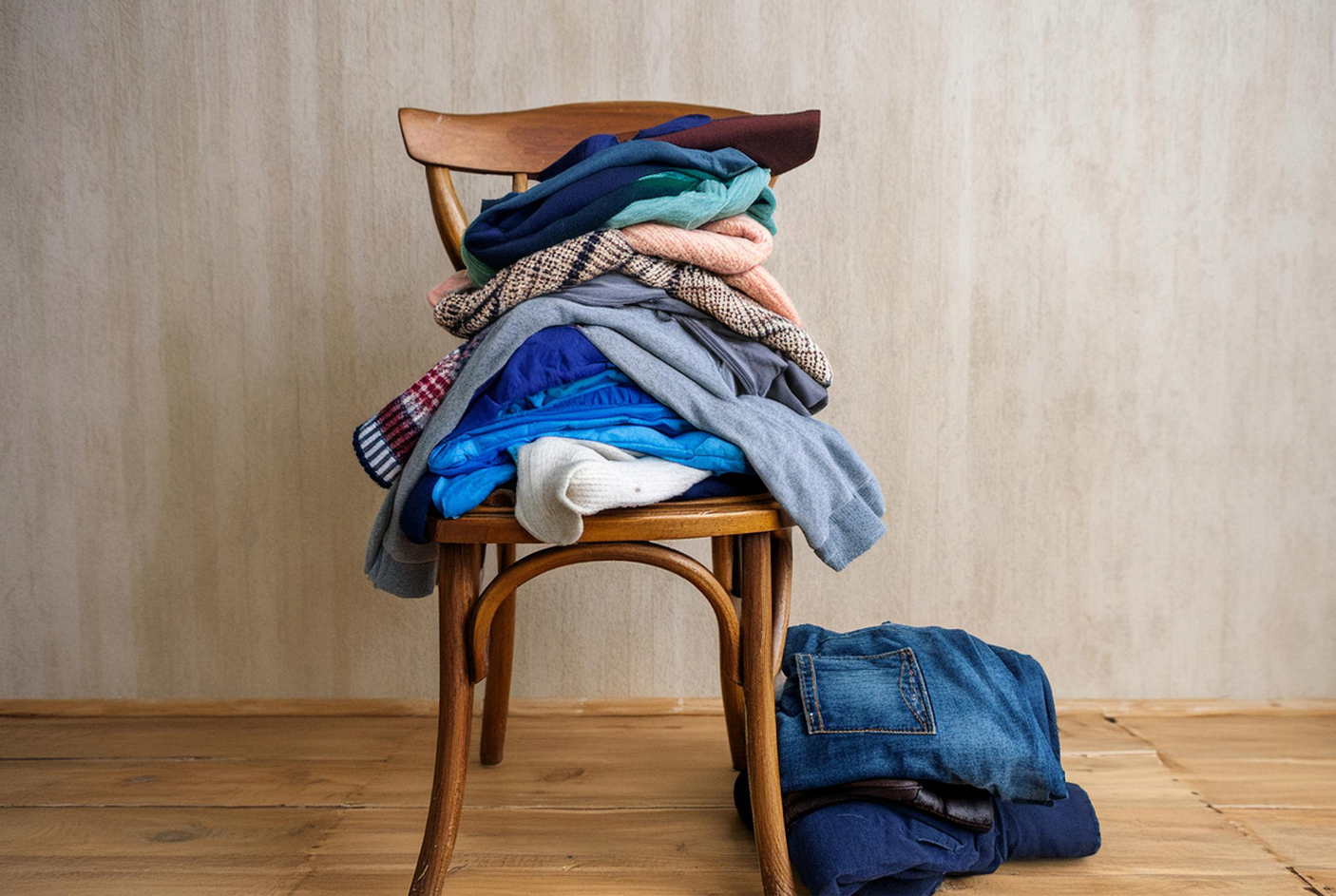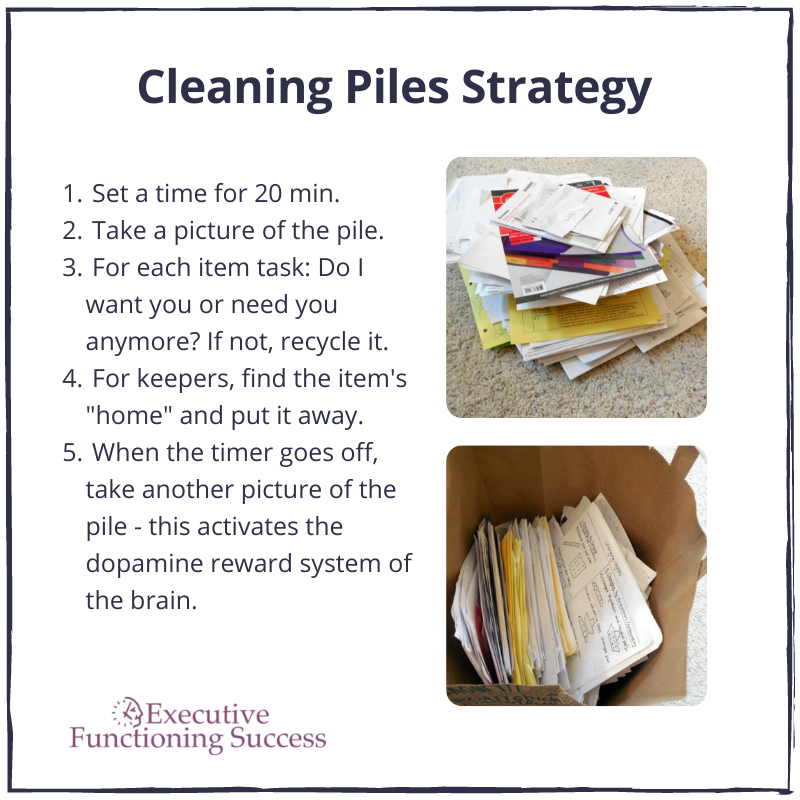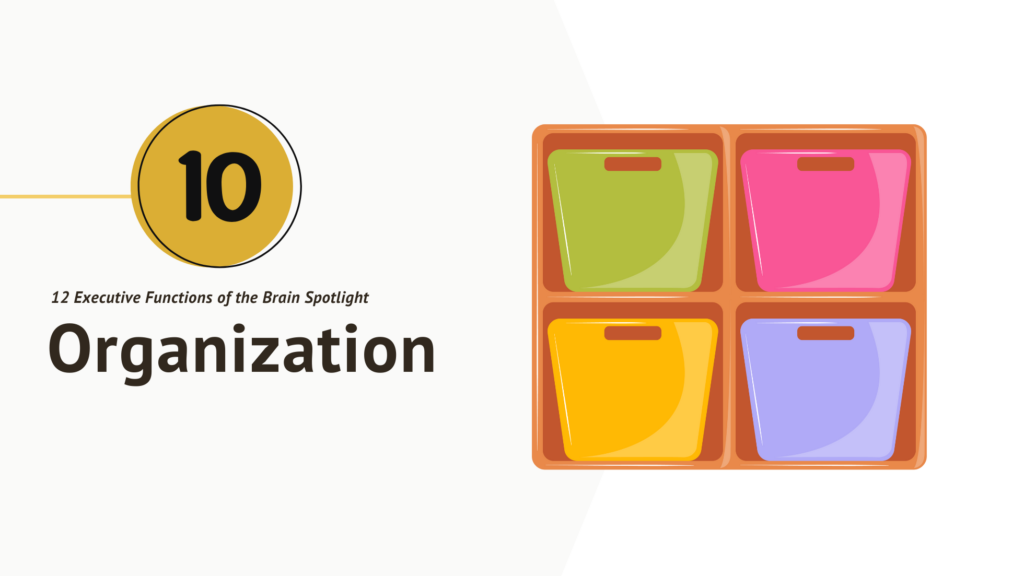We have to organize many things in life: our thoughts, our time, our stuff.
Sorting through thoughts and feelings relates to the executive function of Metacognition. Organizing your time falls under the topic of Time Management.
For this installment of the 12 Executive Functions of the Brain Series, I want to focus on the brain’s ability to organize external objects in our external environment.
Organizing stuff haunts many people. Out-of-control piles are one frequent byproduct of that struggle. Piles of laundry, mail, electronics, dishes…the list goes on. They gather together only to get stuck in perpetual limbo. Many students have rooms and backpacks that are disasters. Adults have homes, cars, and work spaces that are covered in piles of all types.
In our Seeing My Time® program I share this quote: “The mess outside your body creates a mess inside your mind.”
Years after I wrote that line, I was told about research that showed how random piles actually raise the cortisol levels in the brain.
And it’s true! Piles are stressful. Your brain needs an organized environment in order to be calm and to think clearly. A cluttered, messy environment diminishes your other executive function capabilities.
So how to turn those piles into smiles? (Sorry, I couldn’t resist). Let’s get into it.

The First Rule of Organization
I believe that the foundation for consistent and manageable home and office organization is found in this simple sentence: “Everything needs a home.”
It may sound silly, but one great little hack is to think of all objects in your possession as sentient beings with feelings. They want to spend each night in their own bed, at their own home address.
In my office, my mechanical pencil has its own home on my raised computer stand. Its roommate is a yellow highlighter pen.
When things have homes, you can predictably find them when you need them. At the end of each day, that pencil and highlighter pen are put back in their home for the night. I don’t start my day wandering around looking for that pencil.
My glasses and watch “sleep” on the counter of my bathroom sink, along with my little boxes for daily medication and vitamins. Just seeing them on the counter as I brush my teeth is a visual reminder for the pills and to put my watch on. They are in sight, and thus in mind.
Getting Organized with the Pile Clearing Strategy
To create homes for everything, you first need to get those piles under control! If you are shaking your head and getting ready to stop reading at the enormity of such a task, pause. Take a deep breath. You can do this, one step at a time.
As Barbara Hemphill, New York Times best-selling author and pioneer in the organizing industry said, “Clutter is nothing more than postponed decisions.”
That’s right! Each item that gets stuck in that pile needs a decision made about it. My pile-clearing strategy is a way to make those decisions, little by little…
Here’s how you do it.
 Pick ONE pile to work on. Be clear with yourself that the goal is to “make progress” on clearing the pile, not necessarily to eliminate the pile. You’ll need your phone or a camera (do people still have those?), a timer, and several bins, boxes or bags for sorting.
Pick ONE pile to work on. Be clear with yourself that the goal is to “make progress” on clearing the pile, not necessarily to eliminate the pile. You’ll need your phone or a camera (do people still have those?), a timer, and several bins, boxes or bags for sorting.
Step 1: Take a picture of the pile you plan to work on. Just the pile, not the others around it.
Step 2: Set a timer for 20 minutes.
Step 3: With the top object in hand, answer this question: Do I want or need this anymore?
- If the answer is “no”, Place it in a recycle, toss or donate bin.
- If the only reason for keeping the object is an emotional connection to it: Take a picture and donate or toss the item. The picture will give you the same warm feeling but you won’t have to store it or dust it.
- If it is something you spent a lot of money on but haven’t been using: imagine the joy of someone finding it in a thrift store. Let it become someone else’s treasure. Put it in your donate bin.
- If you want to keep it: create a small pile of “keep” items.
- Keep working down through the pile, responding to each of those questions: Toss or keep?
Step 4: Once you have reviewed as much as you can, return to your keep items. Go through each item and ask: Where is its home? Put it away if it already has a home. The challenge of this step is if you haven’t identified the home yet. You have to create it. Do you need a file, a box, a basket, a hanger, a hook? Take the time to set up that object’s home.
Step 5: When the timer goes off, take another picture. And then celebrate your progress! Yay for you! Share your progress with your friends. Let others celebrate with you. You will inspire them to tackle their own piles. We all have a few that need sorting around us!
“With organization comes empowerment.” – Lynda Peterson
Strategies to Maintain Order
Clearing out piles is hard work. All of that decision-making takes up effort and a lot of brain energy. It’s very important to keep your expectations small so you can feel the joy of success that will fuel you to continue to work through your other piles. You can do this.
If you are someone who will go on organizing binges but are unable to sustain that order, try my strategy:
Every time I begin to exit a room, I pause and look back around the space to identify what object is not in its home. I then slip back in and put away those few things so that the room will be tidy when I return. This stops piles from forming.
When I was younger I could have easily opened my door to guests, saying: “Welcome to my piles!”
I’m proud to say that isn’t me anymore. My brain is now much happier and my executive functioning is so much better as a result.
What pile do you want to organize?
Little by little…


